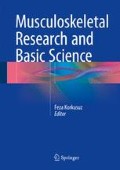Abstract
Biomechanics is the field of study which applies fundamental principles of mechanics to biological problems. Mass, time, and length are the basic variables of the biomechanics, and they are scalar quantities which can be described by a magnitude. Force and moment are vector quantities that take direction (or line) of action into account in addition to the magnitude. Time rate of change of position is velocity, and time rate of change of velocity is acceleration. Force and moment (torque) are the two important concepts at the basis of biomechanics which give forth to linear and rotational motion, respectively. The magnitude of the forces is equal to mass times acceleration. The magnitude of the moment is equal to the force times its moment arm.
The analyses in biomechanics are based on two broad branches of the mechanics: rigid body mechanics and deformable body mechanics. Statics and dynamics are two sub-branches of rigid body mechanics. When the sum of all the forces and moments acting on a body is zero, the body is said to be in static equilibrium. The equations of static equilibrium are often used to calculate unknown forces and moments acting on a rigid body. Dynamics is divided into two subfields: kinematics and kinetics where kinematics explains the motion in linear (meters) or angular (radians, degrees) units. Kinetics is the analysis of forces and moments which give forth to the motion. Newton’s laws, the work–energy relationship, and the principle of energy conservation can be used to document the relationship between force and motion. Motion in the concept of deformable body mechanics is considered as local changes of the shape within a body (internal movement of the body), called deformations. The focus of deformable body mechanics is to analyze experimentally determined relationships between forces and deformations. Forces and deformations apply to structures such as whole bones or implants. At the material level, load and deformation are required to be normalized by cross-sectional area and length, respectively, to obtain stress and strain. Stress–strain relations reveal material properties such as elastic modulus, resilience, ultimate strength, and toughness. Stress–strain curves provide information about the resistance of the material to fracture at a single loading episode, such as trauma. On the other hand, repeated low level of stress results in failure by fatigue. Material properties of materials are dependent on several factors: their composition, environmental and test conditions, and loading schemes. Biological tissues are viscoelastic materials meaning that their deformation depends on the rate and time of loading. Musculoskeletal tissues are also considered as composite materials meaning that they are composed of at least two different materials. The bone is an example where mineral crystals reinforce a ductile collagen matrix. These tissues are also anisotropic materials meaning that their material properties depend on loading direction. For instance, tendon is the strongest when pulled along its longer axis. Finally, it is essential to determine a safe stress level for a structure in order to account for possible uncertainties in its environment.
Access this chapter
Tax calculation will be finalised at checkout
Purchases are for personal use only
References
Meriam J, Kraige L (2011) Engineering mechanics: statics, 7/e. Wiley, New York
Meriam JL, Kraige LG (2012) Engineering mechanics: dynamics (vol 2), 7/e. Wiley, New York
Drillis R, Contini R (1966) Body segment parameters. New York University, School of Engineering and Science, Research Division, New york
Tözeren A (2000) Human body dynamics: classical mechanics and human movement. Springer, New York
Fung Y, Cowin S (1994) Biomechanics: mechanical properties of living tissues. J Appl Mech 61:1007
Bartel DL, Davy DT, Keaveny TM (2006) Orthopaedic biomechanics: mechanics and design in musculoskeletal systems. Prentice Hall, New Jersey
Seeman E, Delmas PD (2006) Bone quality—the material and structural basis of bone strength and fragility. New Engl J Med 354(21):2250–2261
Ammann P, Rizzoli R (2003) Bone strength and its determinants. Osteoporos Int J Established Result Cooperation Between Eur Found Osteoporos Nat Osteoporos Found USA 14(Suppl 3):S13–S18. doi:10.1007/s00198-002-1345-4
Zioupos P, Currey J (1998) Changes in the stiffness, strength, and toughness of human cortical bone with age. Bone 22(1):57–66
Rho J-Y, Kuhn-Spearing L, Zioupos P (1998) Mechanical properties and the hierarchical structure of bone. Med Eng Phys 20(2):92–102
Wang X, Nyman J, Dong X, Leng H, Reyes M (2010) Fundamental biomechanics in bone tissue engineering. Synth Lect Tissue Eng 2(1):1–225
Sedlin ED, Hirsch C (1966) Factors affecting the determination of the physical properties of femoral cortical bone. Acta Orthop 37(1):29–48
Nyman JS, Roy A, Shen X, Acuna RL, Tyler JH, Wang X (2006) The influence of water removal on the strength and toughness of cortical bone. J Biomech 39(5):931–938. doi:10.1016/j.jbiomech.2005.01.012
Lucas GL, Cooke FW, Friis E (1999) A primer of biomechanics. Springer, New York
Burstein AH, Wright TM (1994) Fundamentals of orthopaedic biomechanics. Williams & Wilkins, Baltimore
Özkaya N, Nordin M, Goldsheyder D, Leger D (2012) Fundamentals of biomechanics: equilibrium, motion, and deformation. Springer, New york
Author information
Authors and Affiliations
Corresponding author
Editor information
Editors and Affiliations
Rights and permissions
Copyright information
© 2016 Springer International Publishing Switzerland
About this chapter
Cite this chapter
Ünal, M., Akkuş, O., Marcus, R.E. (2016). Fundamentals of Musculoskeletal Biomechanics. In: Korkusuz, F. (eds) Musculoskeletal Research and Basic Science. Springer, Cham. https://doi.org/10.1007/978-3-319-20777-3_2
Download citation
DOI: https://doi.org/10.1007/978-3-319-20777-3_2
Publisher Name: Springer, Cham
Print ISBN: 978-3-319-20776-6
Online ISBN: 978-3-319-20777-3
eBook Packages: MedicineMedicine (R0)

